In this study, wastewater samples collected from a participating sentinel site were initially screened for the presence or absence of SARS-CoV-2 RNA using portable RT-PCR, with positive samples sequenced using a handheld MinION nanopore sequencing device. Genomic biosurveillance of SARS-CoV-2 and its variants within wastewater has been established as an early warning system of infectious disease spread in a given catchment area, due to good correlation between spikes in viral levels detected in wastewater coincident with increases in COVID-19 incidence rates.1-3
Moreover, viral titers detected in a single wastewater sample are reflective of pre-symptomatic, asymptomatic, and post-symptomatic cases, making wastewater-based epidemiology (WBE) a cost-effective, non-invasive public health surveillance method complementary to clinical diagnostic testing. The results of this study demonstrate the utility of population-scale SARS-CoV-2 epidemiology for insights into the viral evolution and transmission dynamics associated with specific SARS-CoV-2 variants that are necessary for effective strategies of containment and timely deployment of appropriate countermeasures.
What are the new findings?
In this study, 2 different portable nucleic acid detection technologies, RT-PCR and MinION Mk1C nanopore sequencing, identified SARS-CoV-2 variants in wastewater collected at Tyndall AFB during a 2-month surveillance period. This highly multiplexed approach circumvented signal dropout associated with the detection of newly emerging SARS-CoV-2 variants, significantly reducing time for sample-to-pathogen identification, for improved infectious disease surveillance.
What is the impact on readiness and force health protection?
Based on the biosurveillance data obtained through portable detection technologies, viral levels in wastewater monitored at military installations can signify SARS-CoV-2 spatio-temporal dynamics in relation to population density as well as other crucial variables. Wastewater biosurveillance can contribute to data-informed policy decisions such as force health protection condition (HPCON) level adjustments.Wastewater-based epidemiology serves as an early warning system of surges in viral levels in a geographically-defined catchment area that has been utilized to monitor infectious disease emergence and spread, including COVID-19.4-8 Although primary transmission of SARS-CoV-2 is through the respiratory aerosol,9-10 other routes of transmission are possible11,12 as a result of viral shedding due to broad tissue tropism of SARS-CoV-2, including the gastrointestinal (GI) tract.13-15 SARS-CoV-2 lineages were detected in wastewater throughout the COVID-19 pandemic, making wastewater-based epidemiology a valuable tool in understanding and tracking SARS-CoV-2 transmission dynamics at a population level.16-21
Methods
Sample collection from wastewater lift station and initial processing
Site selection for this study was based on reported positive COVID-19 clinical cases. Wastewater influent, prior to any treatment, was collected weekly by an autosampler at a lift station servicing Tyndall AFB in May-June of 2021. During the 8-week study, 50mL composite wastewater samples collected over 24 hours, at 2 hour intervals, were processed for SARS-CoV-2 detection. Each sample was pasteurized at 58oC for 30 minutes to inactivate any virus before further sample handling (Figure 1).
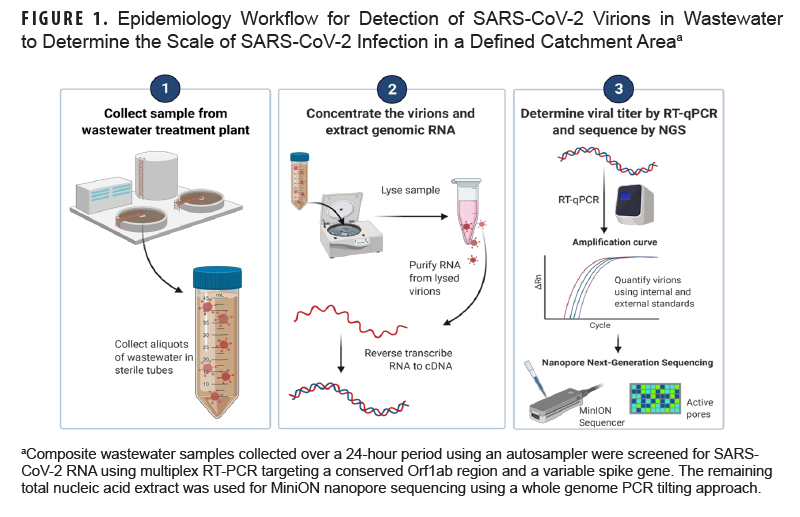
Concentration of virions and genomic RNA extraction
Viral particles were concentrated using 700µL of magnetic nanobeads (Ceres Nano) by incubation at room temperature for 20 minutes, magnetic nanobead collection, followed by supernatant discarding. Viral particles were lyzed and RNA extracted using M1 Sample Prep kit (Biomeme). SARS-CoV-2 virions were lyzed through incubation in lysis buffer for 10 minutes at room temperature, followed by genomic RNA binding to syringe resin, and sequential resin washing to remove protein and salt contaminants. Purified RNA was eluted in 0.2mL buffer and concentration determined with Qubit (ThermoFisher).
Viral titer determination by RT-PCR and MinION sequencing
RT-PCR assay (Biomeme) was performed using SARS-CoV-2 panel targeting Orf1ab gene and S gene. Briefly, 25-100ng of extracted RNA template was added to the lyophilized qPCR mix containing master mix, reverse transcriptase and DNA polymerase enzymes, primers and probes (20µL total reaction volume) under the specific cycling conditions: cDNA synthesis (55oC for 2 min), polymerase activation (95oC for 60 sec), PCR (45 cycles of denaturation at 95oC for 1 sec, and annealing/extension at 60oC for 20 sec). For the SARS-CoV-2 variant assignment, a proprietary variant panel targeted variant-specific mutations and the modified cycling condition of annealing/extension at 62oC for 20 seconds.
To prepare the sequencing library, cDNA synthesis was performed using random hexamers (NEB S1330S) and SuperScript IV reverse transcriptase (ThermoFisher Scientific 18090010), followed by PCR amplification using primers generating 1,200 base pairs (bp) amplicons spanning 29 kilobases (kb) SARS-CoV-2 genome in a tiled fashion with a 20 bp overlap. Odd-numbered primer pairs (FWD+REV primer pairs 1,3,5…29) were pooled in equimolar concentration (Primer Pool 1), while even-numbered primer pairs (FWD+REV pairs 2,4,6...28) were grouped in a separate primer pool (Primer Pool 2). Each sample was amplified twice using primer pools 1 and 2 and Q5 Hot Start High-Fidelity Master Mix (NEB M0494), followed by combining amplicons generated with each primer pool for every sample. Following Agencourt AMPure XP beads clean-up (Beckman Coulter) and Qubit quantification, end-repair and dA-tailing of the amplified cDNA samples used NEBNext Ultra II End Repair/dA-Tailing Module (NEB E7546). Barcode ligation used Native Barcoding Expansion (Oxford Nanopore EXP-NBD104), followed by adapter ligation using Ligation Sequencing Kit (Oxford Nanopore SQK-LSK109) to the pooled barcoded samples (equimolar concentration of 100 fM). After the final AMPure XP beads clean-up and Qubit quantification, the sequencing library was loaded on a primed R9.4.1 flow cell (Oxford Nanopore FLO-MIN106D) and sequenced for 8 hours.
Bioinformatics pipeline for sequence analysis and variant calling
Primary data acquisition used MinKNOW operating software (Oxford Nanopore Technologies), while base-calling employed Guppy (Oxford Nanopore Technologies). Processed reads were mapped against SARS-CoV-2 reference (NC_045512.2, Wuhan-Hu-1) with Minimap 2. SAMtools sorted aligned BAM files for coverage data and a consensus sequence.
Results
Portable multiplex RT-PCR pre-screening resulted in identification of SARS-CoV-2 positive samples
A primary sample screening used multiplex RT-PCR assay with 2 different primers-probe sets targeting SARS-CoV-2 Orf1ab and S-gene. Additional primers-probe set targeting MS2 bacteriophage provided an internal process control. RT-PCR analysis for each sample was systematically performed in triplicate using water as a no-template control. Overall, 6 of the 8 samples tested positive for SARS-CoV-2, evidenced by a positive signal in the red (S-gene) and green (Orf1ab) channels, as well as the corresponding amplification plots and Cq values (Figure 2a), which allowed initial sample assessment for the presence or absence of SARS-CoV-2 RNA.
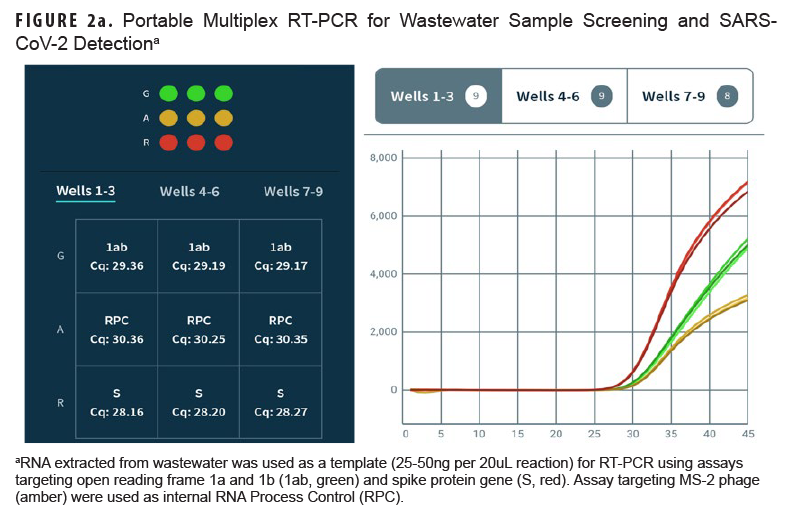
RNA process control (RPC) signal corresponding to MS2 bacteriophage RNA (amber channel) allowed a semi-quantitative estimation of SARS-CoV-2 titer relative to the MS2 phage particles based on corresponding Cq values. Overall, 4 samples contained higher levels of genome copies/mL relative to the internal control (Figures 2b-c), which was consistent with high levels of COVID-19 cases reported at the installation and throughout Florida during the sampling period.
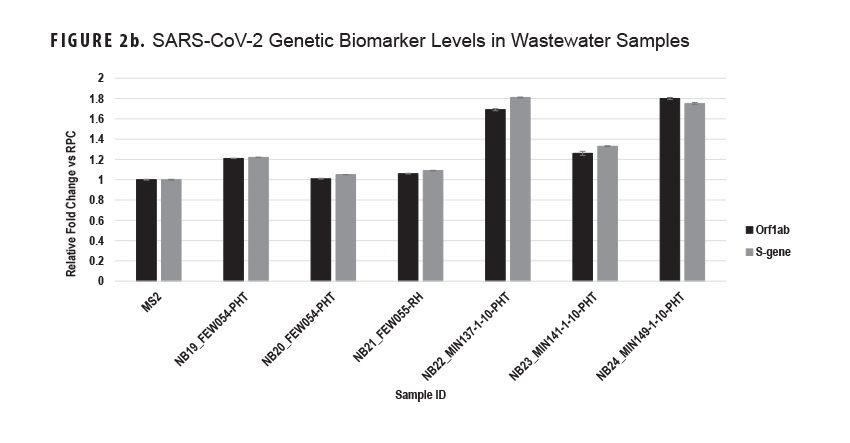
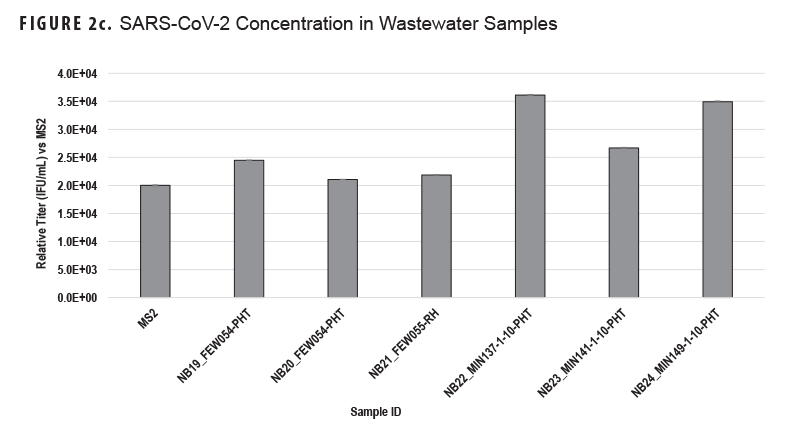
MinION nanopore sequencing using whole genome PCR tiling approach resulted in a comprehensive mutational profiling of SARS-CoV-2 variants
Wastewater samples that tested positive for SARS-CoV-2 RNA were sequenced by tiled amplicon sequencing, while lineage assignment and genome coverage assessment with ARTIC+NextClade bioinformatics pipeline identified distinct SARS-CoV-2 variants in all 6 wastewater samples (Figure 3).
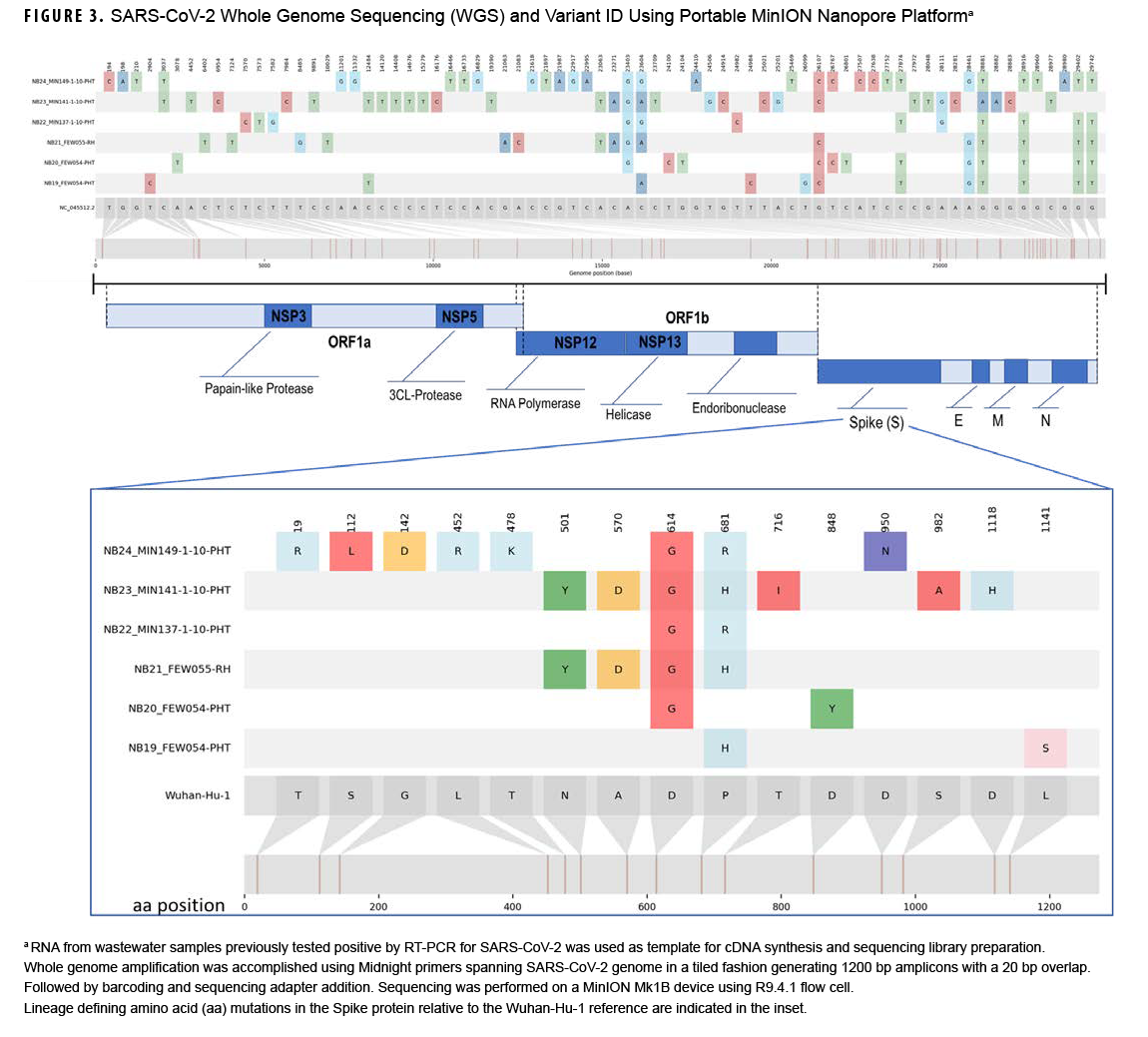
In comparison to the previous ARTIC SARS-CoV-2 sequencing workflow that generated 400 bp amplicons, fewer primer pairs generating longer amplicons resulted in good genome coverage and unambiguous lineage assignment while maintaining good overall sequencing yield and read quality (Table).

A comprehensive mutational profile of SARS-CoV-2 isolates was obtained by whole genome sequencing with varying degrees of nucleotide substitutions, but no deletions or insertions. Lineage-defining amino acid substitutions in the Spike protein were generated using NextClade bioinformatics analysis and included previously uncharacterized mutations (Figure 3). Interestingly, in addition to lineage-defining mutations, additional mutations both in the Spike protein as well as other genomic regions were identified within variants with a defined lineage, e.g. B.1.1.7 (Alpha), thus reflecting the complexity of wastewater samples and genetically divergent SARS-CoV-2 isolates.
SARS-CoV-2 Delta specific RT-PCR assay confirmed lineage assignment by targeting variant defining mutations in the S-gene
Lineage assignment of SARS-CoV-2 variants determined by MinION sequencing was confirmed using a Delta RT-PCR panel of assays targeting mutations specific to the Delta variant (Figure 4).
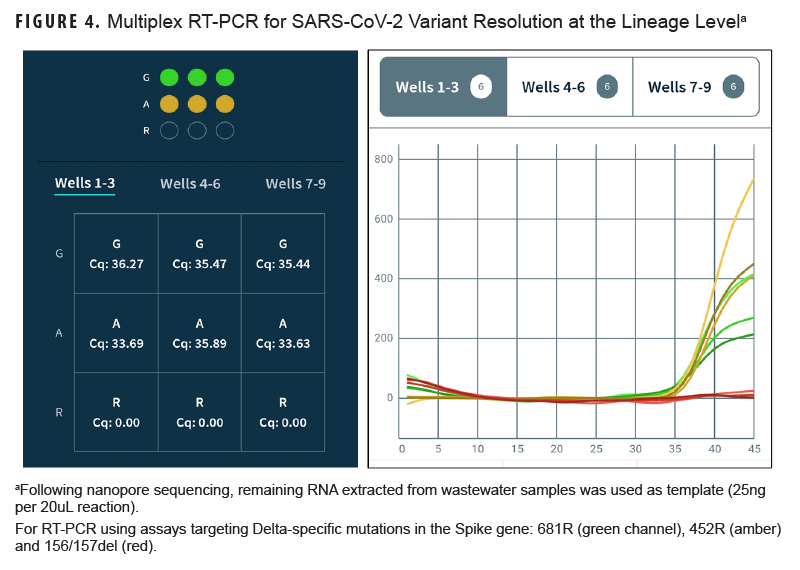
When the wastewater sample NB24_MIN149-1-10-PHT containing SARS-CoV-2 Delta variant, determined by MinION sequencing, was assayed with Delta-specific RT-PCR triplex, the observed signals in the green and amber channels targeting 681R and 452R mutations, respectively, combined with a lack of signal in the red channel targeting deletion at position 156, confirmed unique mutations previously identified with MinION sequencing.
Discussion
In this study, 8 composite wastewater samples were collected, using an autosampler for a 24-hour preiod each week, from a wastewater lift station servicing a military installation. Each sample was screened for SARS-CoV-2 RNA using multiplex RT-PCR targeting a conserved Orf1ab region and variable Spike gene. This method resulted in unambiguous identification of 6 SARS-CoV-2-positive samples, using very low input RNA.
Relatively high SARS-CoV-2 viral titers detected in the wastewater provided good sequencing output, as evidenced by the number of sequencing reads obtained from each sample that tested positive. The RNA material was of sufficient quantity and purity for whole genome tiled amplicon sequencing using long-read nanopore sequencing, allowing several assays for comprehensive SARS-CoV-2 characterization from a single sample source.
Based on this proof-of-concept study, the combination of portable RT-PCR and MinION sequencing for nucleic acid detection can reduce the time for sampling-to-pathogen identification from days to hours (under 10 hours from wastewater sample concentration to SARS-CoV-2 variant identification in the current study) if sampling at the source and circumventing sample transport to a research facility. This method potentially avoids informational loss due to viral instability in the absence of the host, or RNA instability in the absence of the virus.
Lineage ID assignment with ARTIC+Nextclade bioinformatics pipeline allowed identification of variants of concern including Delta and Alpha of the Wuhan-Hu-1 strain originally isolated at the onset of the pandemic. Similarly, 5 of 6 isolates contained P681 mutation in the furin cleavage site (P681 RRAR) at the S1/S2 junction of the Spike protein. P681 mutation renders furin cleavage site less acidic and increases recognition and cleavage efficiency by the furin enzyme, resulting in greater SARS-CoV-2 infectivity. The other notable Spike protein mutations identified with MinION nanopore sequencing included N501Y and L452R, located in the receptor-binding domain and thought to be responsible for more efficient RBD-ACE2 binding and increased viral infectivity.22-27
The presence of S-gene mutations identified with MinION nanopore sequencing was confirmed by a variant-specific RT-PCR assay targeting lineage-defining mutations in the gene-encoding Spike protein. A Delta variant panel targeting 452R, 681R, and 156/157del mutations in the Spike protein that confirmed variant ID assignment was found consistent with the sequencing data, as evidenced by the amplification of the regions encoding the 452R and 681R mutations and absence of signal corresponding to the 156/157 deletion. Interestingly, whole-genome sequencing revealed additional non-lineage-defining mutations in the Spike protein, specifically 112L, indicating the utility of whole-genome sequencing in the SARS-CoV-2 variant tracking and newly emerging variant evolution. It is unclear whether 112L mutation is the consequence of genetic viral diversification from animal reservoirs or human intrahost-dependent viral recombination, as the corresponding clinical SARS-CoV-2 specimens were not available for comparison. Notably, 112L Spike protein mutation is not found in any other variants of concern and has not been linked to any of the evolutionary advantageous viral phenotype traits such as higher infectivity and transmission, more effective replication and potentially increased disease severity due to higher viral burden, or more efficient evasion of host defenses.
At the height of the pandemic, and during specific variants of concern surges such as Delta or Omicron, on average 5-10% of the symptomatic population was tested daily through PCR-based methods or antigen tests, depending on the size of the installation and corresponding population size. This strategy is both cost-prohibitive and labor-intensive for extended periods of time. In contrast, wastewater SARS-CoV-2 levels can be monitored continuously, as demonstrated by this study, on a weekly basis and cost-effectively. A single wastewater sample can be assayed with 1 test per sample to capture a majority of the population, including symptomatic and asymptomatic cases. It is cost prohibitive to continue randomly testing up to 10% of the population when numbers of new cases approach baseline, but continuous monitoring of SARS-CoV-2 levels in wastewater can provide early indicators of SARS-CoV-2 resurgence due emergences of new variants of concern.
Some of the potential limitations of this wastewater biosurveillance include the inability to capture 100% of the population, particularly for more targeted (e.g., building-level) biosurveillance, as an entire population cannot effectively contribute to a sewer shed, particularly from any given building on a sampling day. Wastewater surveillance sustainability at DOD installations will depend upon the ability to expand beyond COVID-19 to include additional pathogens of public health concern. Initial training of bioenvironmental engineering staff is required to make portable WBE feasible.
Overall, portable wastewater SARS-CoV-2 biosurveillance is a sustainable, highly informative, and effective methodology for continuous population monitoring because it can be implemented at the outbreak source, facilitating outbreak containment by providing public health responders with actionable, data-driven information for health force protection more expeditiously.
This study demonstrates the utility of portable RT-PCR and nanopore sequencing platforms for rapid SARS-CoV-2 detection and variant identification at the lineage level, effectively applying this highly multiplexed technology for genomic biosurveillance and public health response to current and future pandemics. Nanopore sequencing in conjunction with variant-specific RT-PCR was validated as an effective method for rapid identification and tracking of the distribution and prevalence of SARS-CoV-2 variants at military installations, which can lack clinical laboratory capabilities while experiencing potential outbreak clusters for newly emerging variants of concern.
Author Affiliations
Air Force Medical Readiness Agency, Falls Church, VA (Lt Col Dietrich); Materials and Manufacturing Directorate, U.S. Air Force Research Laboratory, WPAFB, OH (Dr. Stamps); ERP360 Solutions Group LLC (Craig Strapple); The Henry M. Jackson Foundation for the Advancement of Military Medicine, Inc., Bethesda, MD (Dr. Pavlyuk, Ms. Jacque Engler).
Acknowledgements
The authors would like to thank the Global Emerging Infectious Surveillance and the Department of Public Health and Preventive Medicine of USAF School of Aerospace Medicine at Wright-Patterson AFB, in particular Dr. Anthony Fries and Col. Brett Nishikawa for proofreading the manuscript. HJF award FA8650-18-2-6951 is gratefully acknowledged.
Disclaimer
The views expressed are those of the authors and do not reflect the official guidance or position of the United States Government, the Department of Defense, nor the United States Air Force.
References
- Shah S, Gwee SXW, Ng JQX, et al. Wastewater surveillance to infer COVID-19 transmission: a systematic review. Sci Total Environ. 2022;804(150060):1-37. doi: 10.1016/j.scitotenv.2021.150060
- Prasek SM, Pepper IL, Innes GK, et al. Population level SARS-CoV-2 fecal shedding rates determined via wastewater-based epidemiology. Sci Total Environ. 2022;838(15635):1-8. doi: 10.1016/j.scitotenv.2022.156535
- Schmitz BW, Innes GK, Prasek SM, et al. Enumerating asymptomatic COVID-19 cases and estimating SARS-CoV-2 fecal shedding rates via wastewater-based epidemiology. Sci Total Environ. 2021;801(149794):1-7. doi:10.1016/j.scitotenv.2021.149794
- Wu F, Lee W, Chen H, et al. Making waves: wastewater surveillance of SARS-CoV-2 in an endemic future. Water Res. 2022;219(118535):1-8. doi: 10.1016/j.watres.2022.118535
- Levy A, Gazeley J, Lee T, et al. Whole genome sequencing of SARS-CoV-2 from wastewater links to individual cases in catchments. Sci Total Environ. 2022;851(158266):1-7. doi:10.1016/j.scitotenv.2022.158266
- Wannigama D, Amarasiri M, Hurst C, et al. Tracking COVID-19 with wastewater to understand asymptomatic transmission. Int J Inf Dis. 2021;108:296-299. doi:10.1016/j.ijid.2021.05.005
- Hemalatha M, Kiran U, Kuncha SK, et al. Surveillance of SARS-CoV-2 spread using wastewater-based epidemiology: comprehensive study. Sci Total Env. 2021;768(144704):1-8. doi:10.1016/j.scitotenv.2020.144704
- Hamouda M, Mustafa F, Maraqa M, et al. Wastewater surveillance for SARS-CoV-2: lessons learnt from recent studies to define future applications. Sci Total Env. 2021;759(143493):1-19. doi:10.1016/j.scitotenv.2020.143493
- Tang S, Mao Y, Jones RM, et al. Aerosol transmission of SARS-CoV-2: evidence, prevention and control. Env Int. 2020;144(106039):1-10. doi:10.1016/j.envint.2020.106039
- Chen PZ, Bobrovitz N, Premji Z, et al. Heterogeneity in transmissibility and shedding of SARS-CoV-2 via droplets and aerosols. eLife. 2021;10(e65774):1-32. doi:10.7554/eLife.65774
- Yeo C, Kaushal S, Yeo D. Enteric involvement of coronaviruses: is fecal-oral transmission of SARS-CoV-2 possible? Lancet Gastroenterol Hepatol. 2020;5(4):335-337. doi:10.1016/S2468-1253(20)30048-0
- Zhang J, Wang S, Xue Y. Fecal specimen diagnosis 2019 novel coronavirus-infected pneumonia. J Med Virol. 2020;92(6):680-682. doi:10.1002/jmv.25742
- Gao Q, Chen Y, Fang J, et al. 2019 novel coronavirus infection and gastrointestinal tract. J Dig Dis. 2020;21(3):125-126. doi:10.1111/1751-2980.12851
- Nobel YR, Phipps M, Zucker J, et al. Gastrointestinal symptoms and coronavirus disease 2019: a case-control study from the United States. Gastroenterology. 2020;159(1):373-375. doi:10.1053/j.gastro.2020.04.017
- Papa A, Covino M, Pizzolante F, et al. Gastrointestinal symptoms and digestive comorbidities in an Italian cohort of patients with COVID-19. Eur Rev Med Pharmacol Sci. 2020;24(13):7506-7511. doi:10.26355/eurrev_202007_21923
- Gregory DA, Trujillo M, Rushford C, et al. Genetic diversity and evolutionary convergence of cryptic SARS-CoV-2 lineages detected via wastewater sequencing. PLoS Pathog. 2022;18(10):e1010636. doi:10.1371/journal.ppat.1010636
- Gregory DA, Wieberg CG, Wenzel J, et al. Monitoring SARS-CoV-2 populations in wastewater by amplicon sequencing and using the novel program SAM refiner. Viruses. 2021;18(8):1647-1661. doi:10.3390/v13081647
- Smyth DS, Trujillo M, Gregory DA, et al. Tracking cryptic SARS-CoV-2 lineages detected in NYC wastewater. Nat Commun. 2022;13(1):635-644. doi:10.1038/s41467-022-28246-3
- Wurtzer S, Waldman P, Ferrier-Rembert A, et al. Several forms of SARS-CoV-2 RNA can be detected in wastewaters: implication for wastewater-based epidemiology and risk assessment. Water Res. 2021;198:11783-11793. doi:10.1016/j.watres.2021.117183
- Li B, Di DYW, Saingam P, et al. Fine-scale temporal dynamics of SARS-CoV-2 RNA abundance in wastewater during a COVID-19 lockdown. Water Res. 2021;197:117093-117102. doi:10.1016/j.watres.2021.117093
- Peccia J, Zulli A, Brackney D, et al. Measurement of SARS-CoV-2 RNA in wastewater tracks community infection dynamics. Nat Biotechnol. 2020;38:1164-1167. doi:10.1038/s41587-020-0684-z
- Li Q, Wu J, Nie J, et al. The impact of mutations in SARS-CoV-2 spike on viral infectivity and antigenicity. Cell. 2020;182(5):1284-1294. doi:10.1016/j.cell.2020.07.012
- Hoffmann M, Kleine-Weber H, Pohlmann S. A multibasic cleavage site in the spike protein of SARS-CoV-2 is essential for infection of human lung cells. Mol Cell. 2020;78(4):779-784. doi:10.1016/j.molcel.2020.04.022
- Ozono S, Zhang Y, Ode H, et al. SARS-CoV-2 D614G spike mutation increases entry efficiency with enhanced ACE2-binding affinity. Nat Commun. 2021;12(1):848-857. doi:10.1038/s41467-021-21118-2
- Yurkovetskiy L, Wang X, Pascal KE, et al. Structural and functional analysis of the D614G SARS-CoV-2 spike protein variant. Cell. 2020;183(3):739-751. doi:10.1016/j.cell.2020.09.032
- Korber B, Fischer WM, Gnanakaran S, et al. Tracking changes in SARS-CoV-2 spike: evidence that D614G increases infectivity of the COVID-19 virus. Cell. 2020;182(4):812-827. doi:10.1016/j.cell.2020.06.043
- Kumar A, Prasoon P, Kumari C, et al. SARS-CoV-2 specific virulence factors in COVID-19. J Med Virol. 2021;93(3):1343-1350. doi:10.1002/jmv.26615